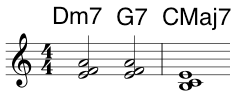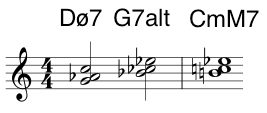Monk
Thelonious Monk is a Bebop Pianist known for his dissonant, quirky and asymmetrical style, rhythm and harmony. So, as you would expect, Thelonious Monk Chord Voicings have a bit of ‘bite’ (read dissonance). They have a semitone interval at the bottom of the chord and a 3rd on top. And because there are only two semitones in a diatonic scale (both Major and melodic minor), then there are only two possible chord shapes – one for the tonic chord and one for every other chord in that key.
Monk Chord Voicings
In short the Thelonious Monk Chord voicings are:
- Major Harmony
- Tonic Major Chord: 7th, 1st, 3rd (B, C, E in the key of C Major)
- Every other chord in the Major Key: 3rd, 4th, 6th of the key (E, F, A in the key of C Major)
- Melodic Minor Harmony
- Tonic Melodic Minor Chord: 7th, 1st, ♭3rd (B, C, E♭ in the key of C Melodic Minor)
- Every other chord in the Melodic Minor Key: 2nd, ♭3rd, 5th of the key (D, E♭, G in the key of C Melodic Minor)
- Dominant chords can be altered to give a bit more bite as follows:
- C7alt = C, D♭, E or D#, E, G or F#, G, B♭ or A, B♭, D♭
You can play a Major and minor II-V-I using Monk Voicings as follows:
| Chord | Notes | Sheet Music |
|---|---|---|
| Major II-V-I | ||
| Dm7 | E-F-A |  |
| G7 | E-F-A | |
| CMaj7 | B-C-E | |
| Melodic Minor II-V-I | ||
| Dø (F melodic minor) | G-A♭-C |  |
| G7alt (A♭ melodic minor) | B♭-C♭-E♭ | |
| CMaj7 (C melodic minor) | B-C-E♭ | |
| C7alt | ||
| C7alt | C-D♭-E; or D#-E-G; or F#-G-B♭; or A-B♭-D♭ |  |
(Aside: Don’t worry too much about the Melodic Minor II-V-I. Each chord is derived from a different melodic minor key (I’ve written them in brackets under the chord). We will discuss this in detail in a future lesson).
Proto-Chords
You may have noticed that if we use ‘Monk Voicings’ then some chords will not have their Guide Tones (3rd and 7th) included in the voicing. In a previous lesson, I stated that when you play a chord you have to include the 3rd and 7th of that chord as a minimum (see Shell Chords). As such, you could argue that these voicings are not really full and proper chords – they are proto-chords or quasi-chord that exist just to create a general ‘feel’ of a particular key and not to strictly play a particular chord. Chord are left intentionally ambiguous. We will encounter this again when we talk about Bud Powell Voicings. It’s up to you how you want to think about chords like these.
Left Handed Voicing
Monk voicings are played entirely with the left hand. This means your right hand is free to play the melody or improvise. In future lessons we will also discuss numerous two handed chord voicings.
The Monk Chord Voicings are particularly easy to remember and play, because there are only two chord voicings in an entire key. But this is also why this chord voicing can become monotonous and dull. If you’re playing a song that is entirely in one key – your chords are going to get awful boring, awful soon. This voicing works better for songs that change keys often.
Have a Listen to
- Any and Every Thelonious Monk Solo